Barometer
Barometer. What is it? What is it for?
A barometer is an instrument used to measure atmospheric pressure. Atmospheric pressure is the force of air at a precise point on Earth. The standard atmosphere (symbol: atm) is a unit of pressure defined as 101,325 Pa (1,013.25 hPa), which is equivalent to 1,013.25 millibars,[1] 760 mm Hg, 29.9212 inches Hg, or 14.696 psi.[2] The atm unit is roughly equivalent to the mean sea-level atmospheric pressure on Earth; that is, the Earth's atmospheric pressure at sea level is approximately 1 atm.
Pressure on Earth varies with the altitude of the surface, so air pressure on mountains is usually lower than air pressure at sea level. As altitude increases, atmospheric pressure decreases. Temperature and humidity also affect the atmospheric pressure. Pressure is proportional to temperature and inversely proportional to humidity. And it is necessary to know both of these to compute an accurate figure.
As altitude increases, the amount of gas molecules in the air decreases—the air becomes less dense than air nearer to sea level. This is what meteorologists and mountaineers mean by "thin air." Thin air exerts less pressure than air at a lower altitude.
Cold air is denser; therefore, it has a higher pressure. Warm air is less dense and has a lower pressure associated with it. As the sun heats the ground, the air near the ground warms.
This means that for the same number of particles, cold air will occupy less volume than warm air.
Due to this, cold air will tend to be heavier and will go towards the ground, while the warm air will tend to be lighter and will rise towards the air.
The barometer is used to measure the pressure exerted by the air on a territory. It is used above all in meteorology and provides important data on the evolution and prediction of the weather.
The atmospheric pressure is not stable and oscillates between 885 hPa between the deepest cyclones (low pressures) and 1077 hPa on the most powerful Siberian anticyclones (high pressures).
A low pressure indicates a depression and therefore bad weather. In the same way, an increase in atmospheric pressure usually indicates that good weather is returning.
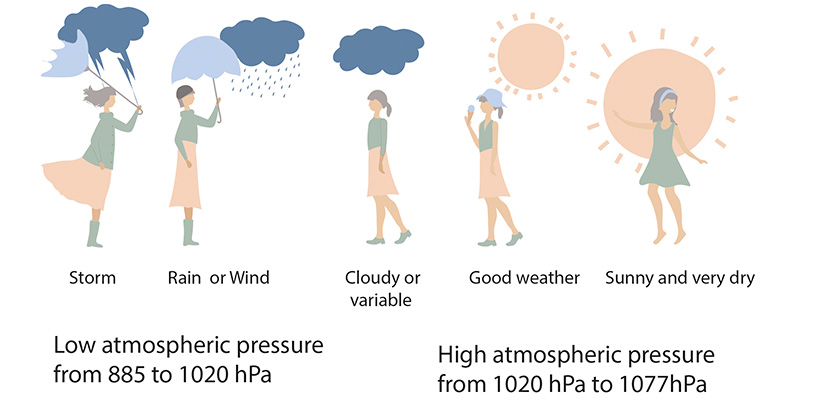
HOW DOES A BAROMETER WORK?
The aneroid barometer that we present to you is made up of thin-walled metal capsules, inside which a vacuum has been made (air has been extracted). As the atmospheric pressure increases, it acts on the walls and the needle rises on the sphere graduated in millimetres or hPa. As the pressure decreases, the capsules dilate and the needle is lowered over the limbus.
A glass lid covers the apparatus. The gold hand is moved by hand with an outer button located in the centre of the crystal. This golden needle serves as a reference. When reading, it is placed on the black needle. This way you know if the pressure has risen or fallen since the last reading, in the interval of time elapsed. It is convenient to take the readings at fixed times and then place the gold needle on the black one.
At home prediction rules
If the pressure drops slowly, below the normal reference level (about 6 mm every 24 hours), the storm passes far.
If the pressure drops rapidly (1 mm. every hour), a deep storm is approaching.
If the barometer rises slowly above the normal value, good dry and anticyclone weather takes hold.
If the barometer rises very abruptly, the improvement may be temporary, as it is the passage of an anticyclonic ridge between two storms.
Pressure rises in coastal areas or valleys, where the air has a lot of built-in density, do not always provide good weather with clear, dry skies, as persistent fog banks can form.
The popular saying collects the behaviour of the barometer in expressions such as:
“A ring around the sun or moon, means that rain will come real soon.”
“If the goose honks high, fair weather. If the goose honks low, foul weather.”
“When your joints all start to ache, rainy weather is at stake.”
“Red sky at night, sailor’s delight; red sky in morning, sailor’s warning.”
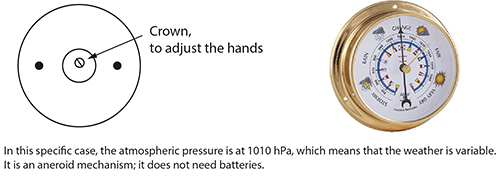
How to set your barometer
Very easy! First of all, you have to find out the atmospheric pressure of the town where you are. You can look at it on your mobile phone or on a weather website, or by searching directly on the internet for “local air pressure….”. Atmospheric pressure is expressed in hPa (hectopascal) or mm (millimetres). Once obtained, set the correct pressure from the back of the barometer, using a small screwdriver and gently (maximum one screw turn). And it's ready!
What causes the change of weather?
Many factors are involved. Among them, the atmospheric or air circulation stands out, which moves constantly in the form of currents and air masses at different temperatures. There are also others, such as solar radiation, atmospheric pressure, geographical factors (latitude), ocean currents, land relief or the vegetation of a certain area. All these factors interact and produce changes that are translated into the different meteorological phenomena.
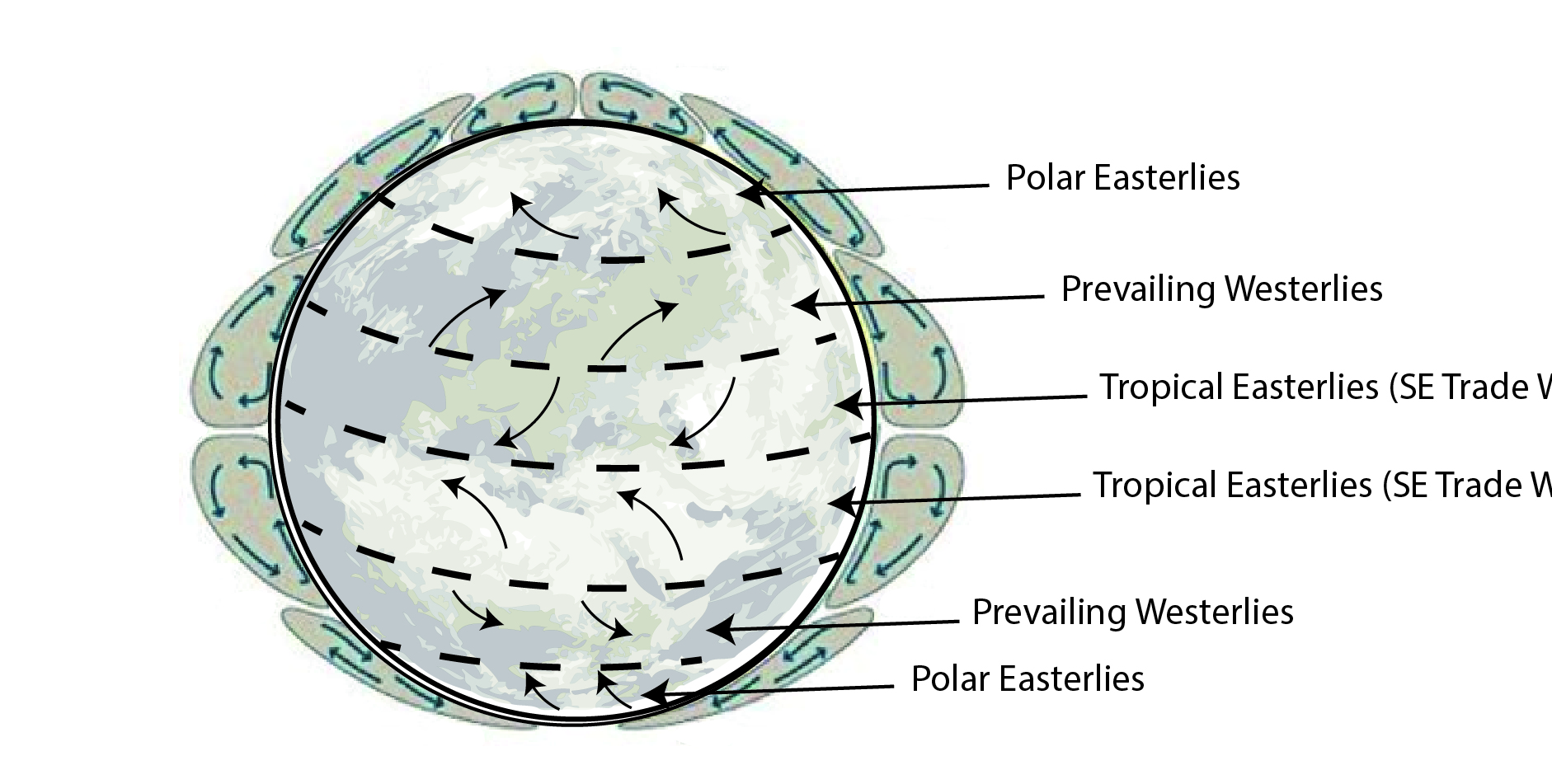
Wind circulation
Atmospheric circulation is the movement of atmospheric air on a large scale and the means by which energy is distributed on Earth (along with ocean circulation).
The atmospheric circulation is variable from one year to another, but its basic operation is constant. The atmospheric circulation is determined by:
1. The constant temperature difference that exists between the equator and the poles.
2. The rotation of the Earth.
3. The presence of continental masses.
Even so, at low latitudes the amount of energy received is greater than that emitted (there is energy gain), while at high latitudes the amount of energy emitted is greater than that received (there is energy loss). Thus, if there was no heat transfer between the tropics and the polar regions, the tropics would get hotter and hotter, and the poles would get colder and colder.
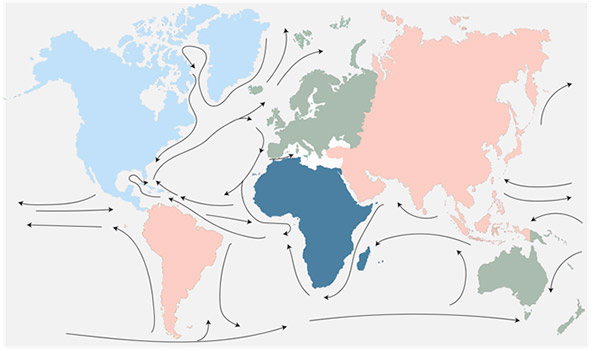
OCEAN CURRENTS
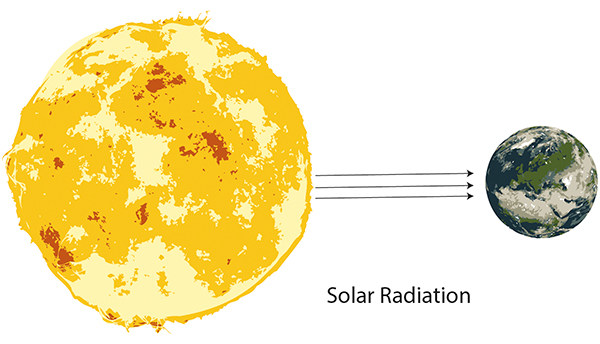
The Sun emits energy in the form of electromagnetic radiation, heating the Earth. However, the distribution of heat along the Earth's surface is not homogeneous: equatorial and tropical regions receive much more solar energy than mid-latitudes and polar regions.
In addition, the Earth also emits radiation into space, but the amount of energy emitted by the Earth is also not homogeneous, since it depends on the surface temperature. Tropical regions, which are hotter, emit more energy than polar regions, which are colder.
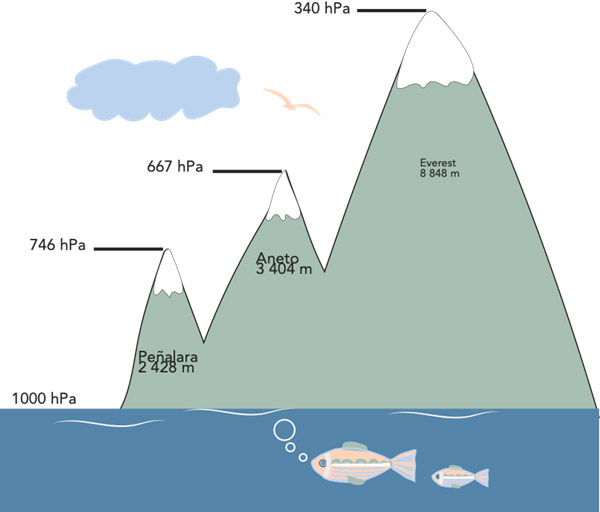
ATMOSPHERIC PRESSURE hPa
The atmospheric pressure approximately drops one millimetre every 11 meters. That is, if we move the barometer from the portal to the roof of a 55-meter house, the pressure would drop 5 mm. For this reason, it is very important to consult a meteorological observatory for the average pressure of the place where you are going to install the barometer.
The elements that make up our barometers
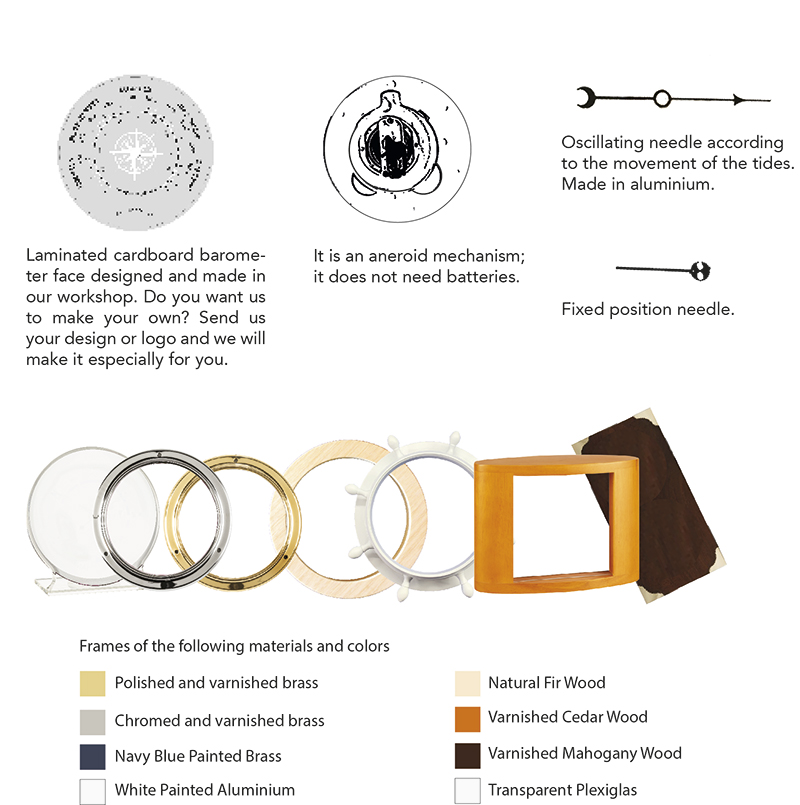
Ocean current energy is the renewable energy source carried by ocean waves, tides, ocean currents, salinity, and ocean temperature differences. It consists of taking advantage of its energy to produce electricity and power homes, transport and industry. It is still a very little used source but in the future it could be important. It is a renewable source and much more constant than wind power and solar power.
How is marine energy produced?
Within marine energies, there are clearly differentiated technologies, depending on the type of energy use. Next, how does marine energy manifest itself?
• Energy from the currents: consists of the use of the kinetic energy contained in the marine currents. The capture process is based on kinetic energy converters similar to wind turbines, using in this case underwater installations.
• Wave energy: the energy derived from the wave movement of the sea water surface. The waves are a consequence of the friction of the air on the surface of the sea, which is why it is very irregular. This has led to the development of multiple devices or sea energy converters according to the device capture principle: oscillating water column (OWC), floating bodies, overflow and/or impact systems, etc.
• Tidal or tidal energy: it is based on taking advantage of the rise and fall of sea water produced by the gravitational action of the Sun and the Moon. The process is based on the storage of water in a reservoir that allows the entry of water or flow to the turbine, in a bay, cove, river or estuary for electricity generation.
• Tidal Thermal Energy: it is based on the use of thermal energy from the sea based on the temperature difference between the sea surface and deep waters. Tidal power plants transform thermal energy into electrical energy using the thermodynamic cycle called the “Rankine cycle” to produce electrical energy whose hot source is the water on the sea surface and the cold source is the water of the depths.
• Blue Energy: it is the energy obtained by the difference in salt concentration between seawater and river water through osmosis processes.
HISTORY OF THE BAROMETER

Evangelista Torricelli (Faenza, 15.10.1608- Florence,25.10.1647)
The creation of the barometer constitutes one of the fundamental events of modern physics. Not only does it reveal the air pressure, but it allows us to refute one of the most deeply rooted prejudices of classical thought: the impossibility of a vacuum.
In 1643, Evangelista Torricelli, a disciple of Galileo, commissioned his friend Viviani to carry out an experiment: he filled a long, hermetically sealed glass tube with mercury and poured it into a bucket filled with mercury. The mercury in the tube is emptied into the container, but a 76-cm column is maintained within the container.
Above, where mercury was before, there is then a vacuum. Torricelli concludes that the layers of air exert, by their own weight, a true pressure on the mercury in the cuvette and that this pressure keeps the column of mercury suspended in the tube.

On September 19, 1648, Blaise Pascal carried out an experiment at the Puy de Dôme (France) by means of two "Torricelli's Tubes" located one at the top of the Puy and the other below, in the valley.
The difference in the level of mercury between the two tubes (more than 8 millimetres) establishes without a doubt that the height of the mercury suspended in the Torricelli tube varies with altitude. And, that the reason for the suspension of mercury is gravity and air pressure. A vacuum is created in the tube when the mercury level drops.
In addition, he notices slight daily variations in the height of the mercury in the column, and concludes that they are due to variations in atmospheric pressure. Torricelli had just checked the air pressure and, at the same time, invented the instrument that allows it to be measured, the mercury (or bucket) barometer.
After the experiments of Torricelli in 1643, of Pascal at the Puy du Dôme in 1648 and of Otto de Guericke of Magdeburg (experience of the hemispheres in 1654), tube mercury barometers were built in series. In 1666, an English builder Thomas Hooke invented the first needle barometer, also called a circular barometer and served as a model for all 18th century salon barometers. Absolutely precious models were created with sculptures and decorations making it an object that is both useful and decorative.
Evolution of the barometer over the centuries

Blaise Pascal (Clermont, 19.06.1623- Paris, 19.08.1662)
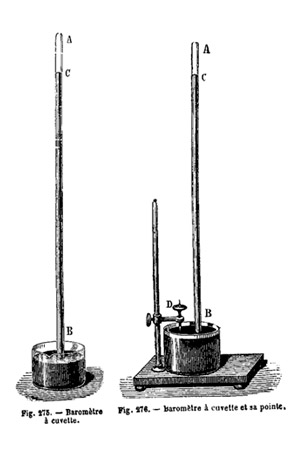
Torricelli's barometer
Approximate date 1643
(Engraving by Camille Flammarion)
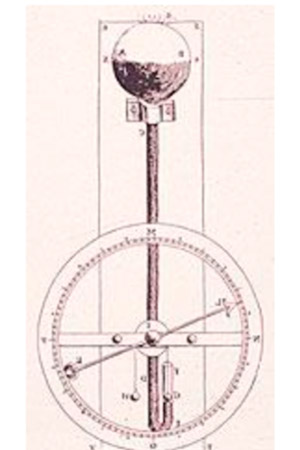
Hooke's Barometer
Approximate date 1660
(Wikimedia source)
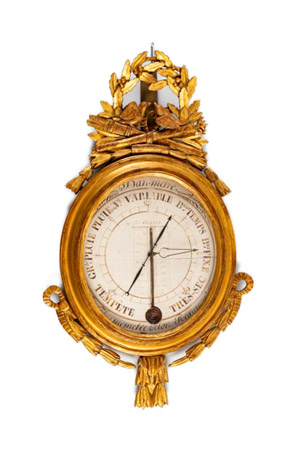
Louis XVI style barometer
France s. XVIII
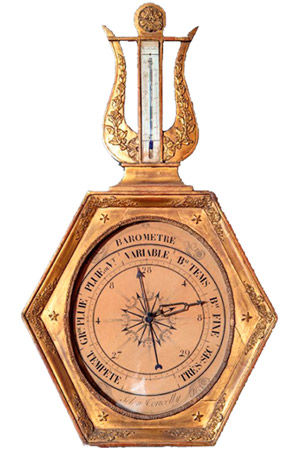
French barometer
Century XVIII
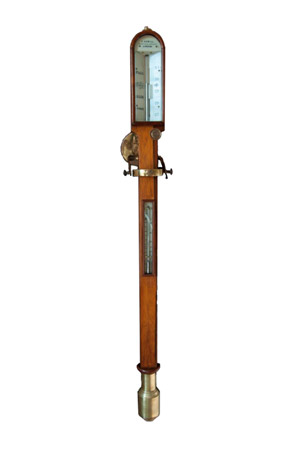
marine barometer
Created by Francis Sewill
(London s. XIX)
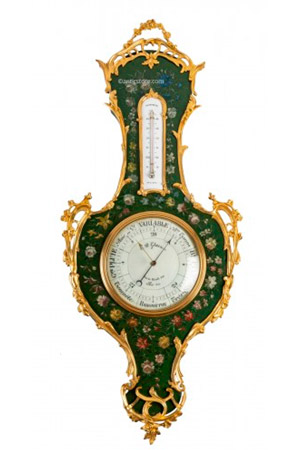
Louis XV style barometer
France s. XIX
If you want to consult more documentation:
https://www.climate-policy-watcher.org/ocean-circulation-3/extratropical-rossby-waves.html
https://www.internetgeography.net/topics/what-is-global-atmospheric-circulation/
https://www.energy.gov/eere/water/marine-energy-basics
https://education.nationalgeographic.org/resource/barometer/
https://www.thoughtco.com/does-atmospheric-pressure-affect-humidity-3976028
We thank the teams that have created these websites that have helped us to document ourselves
